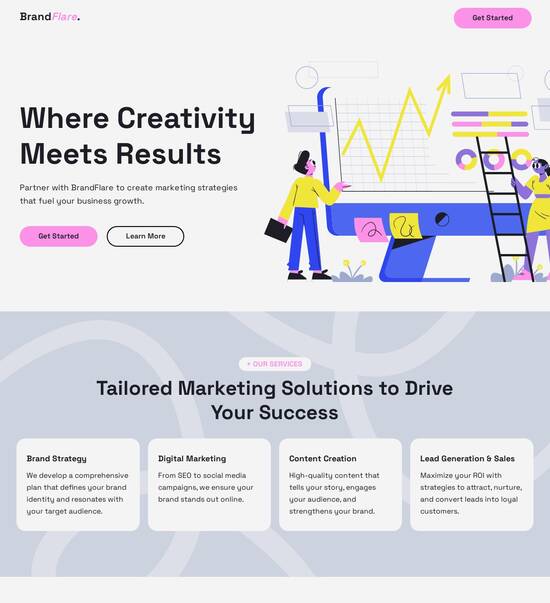
HTML page template for universities
Use TemplateAbout template
Engage your audience like never before with stunning landing page templates for universities. Make your online presence unforgettable!
Recommended templates

Easy to build without coding
With the intuitive drag-and-drop builder, anyone on your team can create high-converting pages without any knowledge of code or design. Make enhancements to your landing page with custom widgets using Javascript, HTML/CSS, or third-party scripts.

Multiple layouts for any industry and goal
Select from 500+ landing page layouts built to boost conversions across industry-specific scenarios. Customize them by adjusting fonts, adding images, and generating on-brand content with the AI assistant. Quickly scale with Instablocks® and Global Blocks that you can save, reuse, and update globally.

Loads fast and looks polished on any device
Every template is responsive, which means they present professionally on any device and load blazingly fast with our Thor Render Engine. You can also power them up with Google AMP technology to deliver an unparalleled mobile experience and drive higher conversions.

Robust analytics & experimentation
Get real-time updates and reporting across all your devices, showing the number of visitors, conversions, cost-per-visitor, and cost-per-lead. Launch AI-powered experiments, run A/B tests, and use heatmaps to analyze user behavior, then optimize your landing page to maximize conversions.







Easy to build without coding
With the intuitive drag-and-drop builder, anyone on your team can create high-converting pages without any knowledge of code or design. Make enhancements to your landing page with custom widgets using Javascript, HTML/CSS, or third-party scripts.
Multiple layouts for any industry and goal
Select from 500+ landing page layouts built to boost conversions across industry-specific scenarios. Customize them by adjusting fonts, adding images, and generating on-brand content with the AI assistant. Quickly scale with Instablocks® and Global Blocks that you can save, reuse, and update globally.
Loads fast and looks polished on any device
Every template is responsive, which means they present professionally on any device and load blazingly fast with our Thor Render Engine.
Robust analytics & experimentation
Get real-time updates and reporting across all your devices, showing the number of visitors, conversions, cost-per-visitor, and cost-per-lead. Launch AI-powered experiments, run A/B tests, and use heatmaps to analyze user behavior, then optimize your landing page to maximize conversions.
All the features you need to build lead-generating landing pages
Explore more featuresLearn how to build top-performing landing pages for any goal
FAQs
Leading the way in building high-performing landing pages





Step-by-step guide to optimizing your landing pages with Instapage
Harnessing the power of Instapage can significantly enhance your digital marketing efforts. As an all-in-one landing page and conversion rate optimization platform, Instapage equips marketers across various sectors, including business services and education, with the tools they need to maximize ROI, engage audiences, and boost conversions through expertly designed landing pages.
Understanding the importance of landing pages
Landing pages serve as the frontline of your marketing strategy, directly influencing conversion rates and the success of marketing campaigns. Leveraging Instapage's library of over 100 customizable templates, you can launch high-converting pages swiftly and efficiently. Key benefits include engaging designs that resonate with your audience and optimized structures that enhance user experience.
- Immediate engagement: First impressions matter; effective landing pages grab attention quickly.
- Targeted messaging: Tailor your content to specific audience segments for improved click-through rates.
- Data-driven decisions: Utilize built-in analytics to refine and enhance your approach.
Creating your landing page
To begin with your landing page creation, follow these essential steps: start by selecting a template that aligns with your campaign goals, utilize Instablocks for organizational ease, and customize elements to fit your branding. Remember to include lead generation tools to maximize information capture.
- Select from high-converting templates that meet your needs.
- Incorporate effective CTAs tailored to your audience's interests.
- Optimize visual elements for faster loading and better UX.
Optimization and testing strategies
Once your landing pages are live, it’s crucial to apply optimization techniques continually. Use A/B testing to compare variations and determine which elements drive the best results. Integrate heatmaps to visualize user interactions and refine your design based on real-time feedback.
- Conduct regular A/B tests to identify top-performing content.
- Analyze heatmaps to understand user interaction patterns.
- Adjust page elements based on performance analytics.
By integrating these principles into your workflow, you’ll ensure that your landing pages not only attract traffic but also convert visitors into leads and customers.
To elevate your marketing strategies, utilizing a structured guide like this ensures focused and actionable improvements in your campaigns.
Ready to accelerate your marketing campaigns? Start a free trial with Instapage today and discover how easy it is to create, optimize, and scale your landing pages!
People also ask about HTML page template for universities
HTML page template for universities
The evolution of university websites: Meeting modern educational demands
In the realm of education, university websites have undergone significant transformation over the years. Initially, early university websites were simplistic, primarily serving as digital brochures that provided basic information about the institution. These early designs often lacked interactive features and visual appeal, making them less engaging for users. As technology advanced, universities recognized the need to evolve, transitioning to more interactive platforms that included features such as event calendars, online application forms, and faculty profiles, thus significantly enhancing the user experience.
The importance of an effective online presence for educational institutions cannot be overstated. With potential students increasingly turning to search engines for information, having a well-structured website not only enhances visibility in search results but also impacts enrollment. Students are more likely to engage with institutions that present a professional and comprehensive digital profile, including virtual campus tours and insightful content.
Educational institutions cater to a diverse audience, including students, faculty, alumni, and donors. Understanding these unique digital needs is crucial. For instance, students seek information about courses and admissions, while alumni might look for networking opportunities. Thus, the content-rich nature of university websites needs to accommodate these diverse user requirements, setting the stage for effective communication and engagement.
Exploring HTML page templates: A game changer for universities
HTML page templates represent a significant leap in web design, particularly for universities aiming to modernize their online presence. These templates can be defined as pre-designed webpage formats that simplify the process of creating and customizing websites. One of the main advantages of using HTML templates is that they accelerate the development process, allowing educational institutions to focus on content rather than design intricacies.
Unlike traditional web design, which may require extensive coding knowledge and technical expertise, HTML templates provide users with a straightforward framework. This distinction is pivotal for universities that might not have in-house web developers. With templates, institutions can create professional-looking websites with essential components, ranging from headers and footers to navigation and content areas, making it easier to achieve an aesthetically pleasing and functional site.
An ideal university HTML template includes key components such as a clear header featuring the institution's logo, intuitive navigation for easy access to various sections, well-structured content areas for information dissemination, and a footer with essential links and contact details. Additionally, responsive design ensures accessibility across various devices, enhancing the user experience substantially.
The power of design wizards: Streamlining the design process
Design wizards are a remarkable innovation, particularly for non-designers in educational institutions. These user-friendly interfaces simplify the web creation process by providing drag-and-drop functionality that allows users to customize templates without needing extensive technical skills. This feature encourages faculty members and administrative staff to take an active role in shaping the university's online presence, fostering a sense of ownership and engagement in the digital sphere.
Moreover, design wizards offer pre-built elements tailored to educational themes, making it easy to incorporate elements like course descriptions, faculty bios, and event listings. Customization capabilities enable institutions to align the color schemes and typography with their branding, ensuring that the website reflects the institution's identity. Additionally, wizards facilitate multimedia integration—such as videos, podcasts, and infographics—which are essential in creating a rich, engaging online experience for visitors.
Leveraging education website templates for enhanced functionality
Pre-designed templates specifically tailored to educational institutions provide a wide range of functionalities. These templates can fall into various categories such as research-focused, community engagement, or alumni relations. Each category offers unique features aimed at enhancing specific aspects of university life. For instance, a research-focused template might include sections dedicated to faculty publications, ongoing projects, and grant opportunities.
The functional highlights of these templates are worth noting. They often include event listings for campus activities, course catalogs for viewing academic programs, and faculty showcases to highlight expertise. Moreover, integration with e-learning platforms enables universities to seamlessly incorporate Learning Management System (LMS) tools. This compatibility supports virtual classrooms, allowing institutions to distribute resources and facilitate remote learning—an increasingly important feature in contemporary education.
Top features of HTML page templates for universities
Optimizing HTML page templates for SEO is crucial for improving visibility on search engines. Features such as metadata fields and alt text functionalities enhance searchability, driving more traffic to university websites. For instance, effectively keywording content and using relevant tags increases the chances of appearing in search results related to academic programs and campus events.
Furthermore, mobile responsiveness and cross-platform compatibility are essential in today’s digital world. Templates must ensure site usability across smartphones and tablets, adapting to various screen sizes without sacrificing functionality. This adaptability caters to the increasing number of users accessing university websites via mobile devices. Additionally, compliance with accessibility standards, such as ADA and W3C guidelines, helps create inclusive educational resources. By prioritizing accessibility, universities can cater to all users, including those with disabilities.
Comparative analysis of design platforms: Choosing the right fit
When it comes to selecting a design platform for educational websites, various options available offer differing features and functionalities. Platforms such as Instapage stand out due to their specialization in creating landing pages tailored to marketing needs. By comparing Instapage with other design tools, universities can identify which platform best aligns with their objectives.
Strengths and weaknesses of each platform come into play when making a choice. Instapage, for example, offers flexibility and an extensive library of conversion-focused layouts, but may come at a higher cost compared to simpler alternatives. On the other hand, platforms designed for ease of use may lack some of the advanced optimization features that educational institutions need. Overall, evaluating pricing, usability, support, and features is essential to determining the right fit for each unique educational context.
Case studies: Universities utilizing HTML page templates effectively
Numerous universities have successfully adopted HTML page templates, leading to remarkable improvements in their online presence. For instance, some institutions have highlighted their innovative designs through user-friendly interfaces that showcase academic programs and student life. These efforts often result in measurable benefits such as increased enrollment figures and improved student engagement, positioning these universities as frontrunners in digital marketing within the education sector.
Lessons learned from these case studies underline the importance of continuous optimization and implementation of best practices. Institutions can gain valuable insights into what works best for their audiences—particularly regarding the layout, content, and functionalities of their web pages. Strategies for ongoing updates, seeking user feedback, and staying abreast of industry trends can help universities keep their websites relevant and efficient.
Future trends in university website design
As the digital landscape constantly evolves, so too do the trends in university website design. The digital transformation within educational institutions is opening new avenues, such as the rise of AI technologies, which could lead to the introduction of more personalized learning environments. Additionally, emerging technologies like virtual reality (VR) and augmented reality (AR) present exciting possibilities for immersive educational experiences. These advancements will reshape how content is delivered, likely creating deeper engagement and interaction.
Anticipating user needs remains critical as these trends develop. The future of education websites will rely heavily on continuous evolution of templates and design features while integrating user feedback mechanisms. This adaptive approach to design will ensure that institutions can respond effectively to the changing preferences of students and faculty, ultimately creating a more engaging digital experience for all stakeholders.
The strategic implementation of HTML page templates
Successfully deploying HTML page templates involves mapping institutional goals to specific design objectives. Before implementation, it is vital to assess the university's unique requirements and the demographic it serves. Collaborating with stakeholders such as faculty, students, and IT professionals ensures that the end product meets the needs of all users.
Monitoring and adjusting strategies based on performance metrics is essential for maintaining an effective website. Tools like Google Analytics provide insights into user behavior, which can inform ongoing improvements. Evaluating user experience through surveys and feedback forms contributes to an iterative process, allowing universities to make data-driven changes that optimize site functionality, engagement, and accessibility.
Ready to skyrocket conversions?
Supercharge your ad campaigns with high-performing landing pages
Get started














